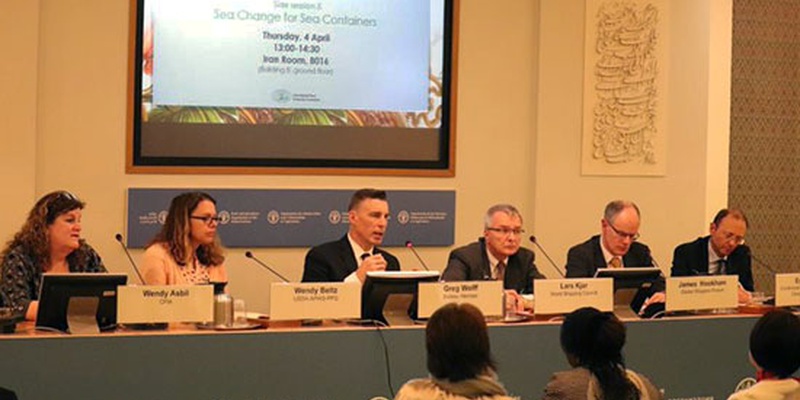Sea change for sea containers: CPM-14 Side Session
Posted on Mié, 17 Abr 2019, 07:06

The Sea change for sea containers side session highlighted pest risks associated with sea containers and their cargoes - and what can be done to reduce these risks. © FAO
4 April 2019, Rome - It was standing room only at the side session on sea containers held at the recent Commission on Phytosanitary Measures (CPM-14) meeting. Over 100 participants learned more about the complexity and challenges of sea container logistics, the risks contaminated containers and their cargos pose to plant resources, and the efforts made by government and industry to reduce those risks.
How government and industry can reduce pest risks associated with sea containers and their cargoes
The North American Sea Container Initiative (NASCI) is an example of how government and industry can collaborate to more effectively reduce plant pest risks associated with the movement of sea containers and their cargoes; and drive positive change by adopting and promoting good phytosanitary practices.
Ms Wendy Asbil and Ms Wendy Beltz from NASCI presented the objectives of the NASCI action plan, highlighted the work accomplished since 2017 and future activities. See the NASCI presentation at:
https://www.ippc.int/en/publications/87105/
Reducing risk along international container supply chains
People working in the sea container industry can raise awareness among their peers to promote best practices and reduce risk. In turn, this will result in fewer rejections and delays along the supply chain.
The risk of pests contaminating containers and cargo is greatest at the packing location. This implies that shippers and packers, acting on behalf of shippers, should put measures in place to minimize pest contamination during packing.
However, other operators in the international container supply chain - such as container operators and consignees - should also put measures in place to reduce the risk of pest contamination while the container is under their control. These measures should be in accordance with the parties roles and responsibilities in the supply chain as set out in the IMO/ILO/UNECE Code of Practice for Packing of Cargo Transport Units, and should take into consideration all safety and operational constraints.
Mr Lars Kjaer from the World Shipping Council (WSC) and Mr James Hookham from the Global Shippers Forum discussed container logistics and the roles and responsibilities of container operators, shippers, packers and consignees in minimizing pest contamination of containers and their cargoes. See their presentation at:
https://www.ippc.int/en/publications/87106/
The Good Phytosanitary Practices Program (GPP)
Italy was the first in the world to create a program of good phytosanitary practices for exports. The Italian ceramic industry, in particular, continues to be concerned about the environment and ecosystems. The Good Phytosanitary Practices Program (GPP) is promoted by Confindustria Ceramica, the Italian Ceramics Association, and supported by CTDA, the U.S. Ceramic Tile Distributors Association.
The programme is a new way to safeguard both the environment and international trade. It is a viable model for ceramic companies from other countries, or other interested sectors, aiming to reduce the worldwide risk of phytosanitary contamination through sea cargo shipments. The program has been in use since August 2014. Its very positive results were presented by Enrico Lupi, representative from Confindustria Ceramica. See the GPP presentation and video at:
-
GPP presentation: https://www.ippc.int/en/publications/87107/
-
GPP video: https://www.ippc.int/static/media/files/publication/en/2019/04/Slideshow_2019_ROMA.mp4
Sharing experiences and best practices
The side session presented further opportunities for countries to share experiences and best practices regarding their outreach and awareness campaigns, and how they promote the use of the Cargo Transport Units (CTU) code, joint industry cleaning guidelines and other related practices.
They also highlighted current risks and how these are mitigated at the national level. Presenters included Dr Kim Ritman, Australian Chief Plant Protection Officer, Ms Guanghao Gu, Deputy Director, Animal and Plant Quarantine Division, Shenzhen Customs District, China and Mr Peter Thomson, Director of Plant and Pathways, Regulation and Assurance, Ministry for Primary Industries, and Head of the New Zealand Delegation.
Conclusion
Participants agreed there was a need for more collaborative work to reduce risks associated with the movement of sea containers. The IPPC community, industry and relevant international organizations also need to be fully involved. A more balanced approach can be guaranteed through the implementation of good practices by industry under the oversight of national plant protection organizations (NPPOs). A comprehensive standard to provide provisions on sea containers cleanliness would be important as well.
More information
More information about sea containers is available at:
https://www.ippc.int/en/core-activities/capacity-development/sea-containers/
IPPC Guidelines on Sea Container Surveys for NPPOs in all FAO languages are available at:
https://www.ippc.int/en/publications/87069/
Side session on sea containers webcast:
http://www.fao.org/webcast/home/en/item/4971/icode/
Related news article:

